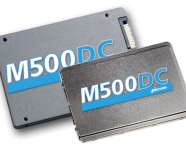Review: Micron M500DC & Crucial CT480M500 SSD
I have entirely done away with running my personal and professional workloads on spinning rust. In my desktop, I’ve been running a Crucial CT480M500 480GB SSD for at least the last 18 months. My laptop is a bit newer at just about 6 months and the second we received it we swapped out the generic Toshiba 5400RPM drive for a shiny M500DC 480GB SSD from Crucial’s parent company, Micron.
My workloads generally consist of normal document processing and internet browsing up to audio & video editing, rendering and of course, gaming. These workloads are far from anything overwhelmingly IO intensive like you’d expect from a reasonably-sized data center (I am but one man!) but if there’s one thing I am above all else, I am impatient.
Load times lead to frustration and boredom. Boredom leads to finding something else to do. Finding something else to do leads to forgetting about what I was originally doing, hate leads to suffering, yada yada yada. Long story short: it’s bad for productivity (and my blood pressure) to work on crappy hardware.
Fortunately, both the Crucial CT480M500 and the Micron M500DC have allowed me to get a clean bill of health from my doctor or physician. As far as my day-to-day workloads go, they serve things up just fine. I’ve gone from hibernating my workstations to simply powering them off because the time from a cold start to where I want to be is so negligible, I may as well reap the benefits of saving everything I have open and getting a fresh boot each time (all of this made easier by the nature of a large portion of modern software being cloud and browser-based). At 480GB (with models of varying sizes) I have enough capacity to locally install everything I need and back it up to a NAS.
Crucial products are generally aimed at the consumer market, whereas Micron targets the enterprise so it didn’t come as too big of a shock to me to see that the Micron M500DC is a little bit faster than it’s Crucial counterpart. Considering it comes with a higher price tag ($467.99 for the Micron M500DC compared to $247.99 for the Crucial CT480M500) and sports some added bells and whistles such as Micron’s eXtended Performance and Enchanced Reliability Technology (XPERT).
The first of these technologies is adaptive read management/optimized read (ARM/OR) which dynamically tunes the read settings for optimized performance by monitoring and changing the NAND voltages as the gates wear down.
Next, there’s Redundant Array of Independent NAND (RAIN), which uses a similar block-level structure to RAID 5 to protect against data loss by using the parity to recover data in the event of a block failure. DataSAFE ” embeds memory ECC and LBA data as metadata with sector data to ensure that data being read from NAND is always the same data the host requested.
Comparatively, the Crucial CT480M500 has a bit less going for it (excluding the difference in price point). It boasts 256-bit AES encryption at the hardware level and TCG Opal 2.0 compliant firmware which allows the drive to operate at full speed without significant performance loss. It can also dynamically adjust power consumption to help keep things cool in your system. Beyond that, it’s a standard-fare consumer grade SSD.
Fortunately, the feeds and speeds are nothing to scoff at for either of these drives and for me, performance is what matters most (after cost and capacity, anyway). Again, it should come as no surprise to see the Micron M500DC be slightly faster in nearly every test we threw at it. A smart person would swap the Micron M500DC from his laptop to his Xeon-powered desktop workstation… Another project for another day.

Micron M500DC – IOMeter

Crucial CT480M500SSD1 – IOMeter
In IOMeter, we can see a clear advantage in the M500DC. Both drives are capable of reaching over 100 MBps read/write, but the Micron M500DC peels ahead with just over 25% more IOPs and a significantly lower range of latency.

Micron M500DC – CrystalDiskMark

Crucial CT480M500SSD1 – CrystalDiskMark
Again, the same story: the M500DC is faster in every way, most noteworthy is the difference in write speed. Results in our other tests (AS SSD, HD Tune Pro, Atto Disk Benchmark & more) all confirmed the same thing. The M500DC is really showing its enterprise side here – datacenter workloads are much more varied than anything I alone would throw at it and the added sturdiness of the M500DC makes it much more capable of filling a plethora of different holes. For my personal and professional uses, these differences don’t hugely impact me.
The lesson here is to know your workload. The Micron M500DC might be a bit overkill for my needs when all is said and done, but I’m absolutely not going to complain about added flexibility and reliability. The consumer-oriented Crucial CT480M500 (I have the SSD1-suffixed model but the internet tells me Crucial is up to SSD3 in this line) cheerfully serves my purposes.
- Video Review: Solarwinds Virtualization Manager - February 17, 2017
- ioFABRIC Vicinity 1.7 Video Review - December 1, 2016
- Marvel vs Capcom 4 rumors gain momentum - November 29, 2016
- SFP cables suck and I hate working with them. - November 1, 2016
- Lit Screens: Killer robots, exploding phones, and new controllers - October 14, 2016
- Preorders are crap and you’re part of the problem - October 13, 2016
- Esports acquisitions, Virtual Reality and Political Overtones, Oh My! - October 11, 2016
- Playlist-based Matchmaking is crap. - October 6, 2016
- Kerbal Space Program devs jettison their (un)payloads from Squad - October 6, 2016
- TwitchCon, Brooklyn Beatdown, No Man’s Sky and Hearthstone - September 30, 2016






